Skin cancer is the most common cancer worldwide, with 1 in 5 Americans developing it by age 70. Every day, over 9,500 new cases are diagnosed, according to the American Academy of Dermatology. This isn’t just a statistic—it’s a growing health concern that affects millions.
Australian cricket legend Michael Clarke recently reminded the world of its seriousness. After having another lesion (first in 2006) removed from his nose, he urged everyone to stay alert: regular check-ups, knowing the early skin cancer symptoms, and prevention are key.
“Skin cancer is real! Especially in Australia. A friendly reminder to get your skin checked. Prevention is better than cure but in my case, regular check ups and early detection is key.” Source: Times of India
Clarke’s story highlights an important truth: skin cancer is common, but also one of the most preventable and treatable cancers—especially when caught early. This guide will help you recognize key skin cancer symptoms, understand different types, learn simple self-exam steps, explore modern treatments, and follow proven prevention strategies to protect yourself and your family.
Table of Contents
What is Skin Cancer? A Guide to the Main Types
At its core, skin cancer develops when abnormal skin cells grow uncontrollably. This usually happens after DNA damage—most often from ultraviolet (UV) rays from the sun or tanning beds—causes mutations. These mutations trigger rapid cell growth, forming malignant tumors that can invade and damage healthy tissue. According to the Mayo Clinic, the type of skin cancer depends on the specific cells where it begins, which makes recognizing skin cancer symptoms even more important.
Basal Cell Carcinoma (BCC): The Most Common Form
Basal Cell Carcinoma (BCC) is the most common type of skin cancer worldwide. It begins in the basal cells, found in the lower part of the epidermis (the skin’s outer layer). Although BCC is usually slow-growing and rarely spreads to other parts of the body, ignoring early skin cancer symptoms can be risky. Left untreated, it can grow deeper, damaging nerves, bones, and surrounding tissue. The American Academy of Dermatology emphasizes the importance of early detection and treatment.
Appearance (Symptoms): BCC can be deceptive and present in several ways. Key signs to watch for include:
- A flesh-colored, pearl-like bump that may be translucent, allowing you to see tiny blood vessels.
- A pinkish patch of skin, especially on the chest or back.
- A sore that bleeds, heals, and then returns in the same spot.
- A flat, firm, pale or yellow area, similar to a scar.
- Small, shiny pink or red bumps, which might have blue, brown, or black areas.
Risk Profile: BCC is strongly linked to long-term, cumulative sun exposure. It most often appears on sun-exposed areas like the head, neck, and arms. While it is most common in people with fair skin, individuals of all skin tones can develop it. Studies show it is the most common skin cancer in Caucasians, Hispanics, and Asians.
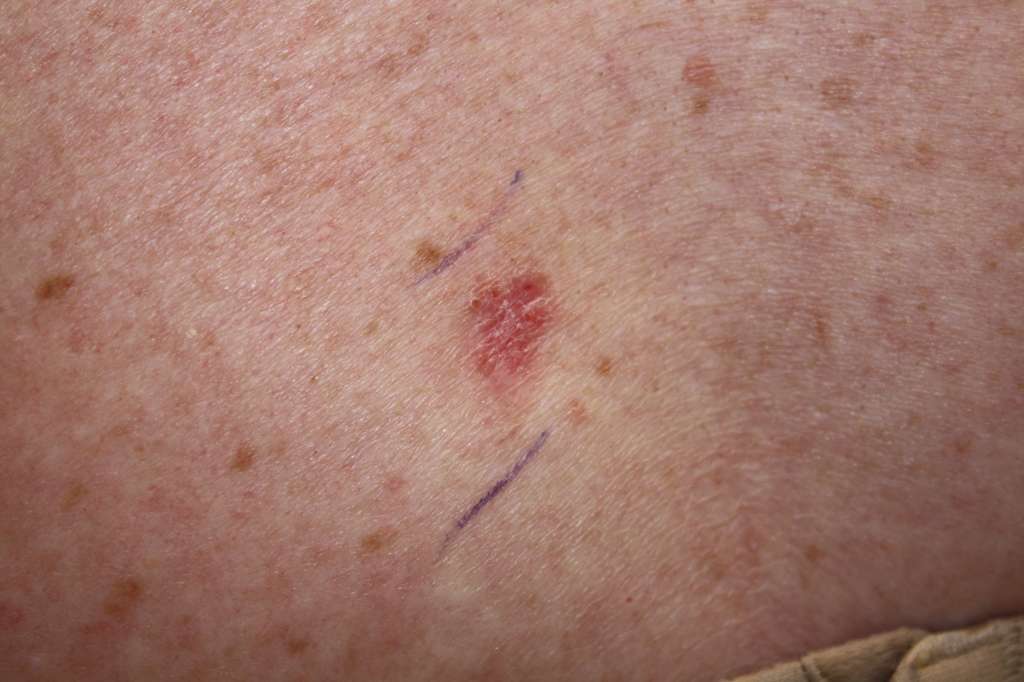
Squamous Cell Carcinoma (SCC): The Second Most Common
Squamous Cell Carcinoma (SCC) is the second most common type of skin cancer. It starts in the squamous cells, which are flat cells found in the upper layers of the epidermis. Unlike Basal Cell Carcinoma, SCC is more aggressive and carries a higher risk of spreading if left untreated. Recognizing early skin cancer symptoms is critical, as the American Cancer Society warns about its potential to invade deeper tissues and spread to other parts of the body.
Appearance (Symptoms): SCC often appears on sun-exposed areas like the face, ears, neck, lips, and back of the hands. Its common presentations include:
- A firm, red bump or nodule.
- A flat lesion with a scaly, crusted surface.
- A wart-like growth that may crust or bleed easily.
- An open sore that heals and then re-opens, or a sore that never fully heals.
- It is often rough to the touch due to a buildup of hard, dead skin (hyperkeratosis).
Risk Profile: Like BCC, SCC is heavily linked to sun damage. However, other factors can increase risk, such as having a weakened immune system (due to certain medical conditions or immunosuppressant drugs), a history of radiation therapy, or exposure to certain chemicals. SCC can also develop within existing scars or chronic skin sores. MD Anderson Cancer Center notes these additional risk factors.
Precursor Lesion – Actinic Keratosis (AK): It’s important to mention Actinic Keratosis, also known as solar keratosis. These are dry, scaly patches or spots that are considered pre-cancerous. Caused by years of sun exposure, an AK can progress into a Squamous Cell Carcinoma. Treating AKs is a key step in preventing SCC. The AAD emphasizes the importance of treating these precancerous growths.
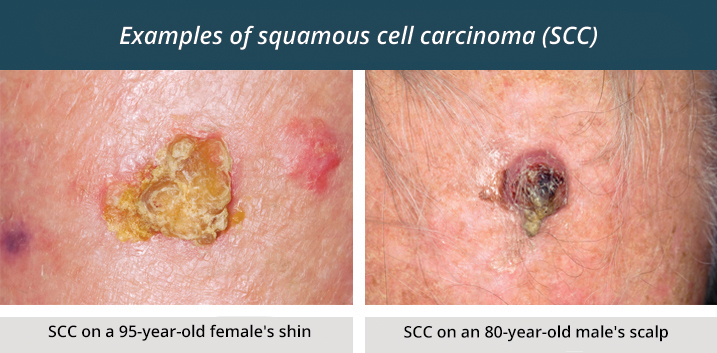
Melanoma: The Most Serious Type
Though less common than BCC and SCC, melanoma is the most dangerous form of skin cancer. It develops in the melanocytes, the cells that produce melanin—the pigment that gives skin its color. Melanoma has a high propensity to spread to other organs if not caught in its earliest stages, which is why it is responsible for the majority of skin cancer deaths. The American Cancer Society refers to it as the most serious skin cancer.
Appearance (Symptoms): Melanoma may start in an existing mole or appear as a new dark spot. Unlike harmless moles, melanomas usually look unusual. The best way to recognize early skin cancer symptoms is by using the ABCDE rule, which we’ll explain next.
Risk Profile: The main risk for melanoma is UV exposure, especially intense sunburns from intermittent sun exposure. Other risks include having 50+ moles, atypical (dysplastic) moles, fair skin that burns easily, a personal or family history of melanoma, and certain genetic factors. The American Cancer Society highlights these risks, stressing the need to watch for early skin cancer symptoms.
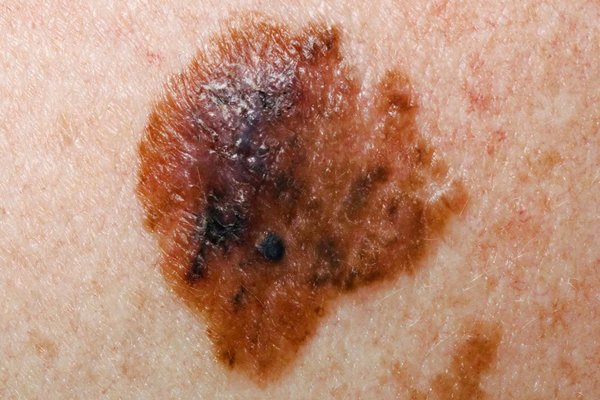
Less Common Skin Cancers
While BCC, SCC, and melanoma account for the vast majority of cases, other rarer types of skin cancer exist. These are treated differently and have unique characteristics. They include:
- Merkel Cell Carcinoma: A rare, aggressive skin cancer that often appears as a firm, painless lesion or nodule on sun-exposed skin.
- Kaposi Sarcoma: A cancer that causes lesions in the soft tissues, often appearing as red or purple patches on the skin or mucous membranes. It is typically associated with a weakened immune system.
- Cutaneous (Skin) Lymphoma: A type of non-Hodgkin lymphoma that starts in the skin.
- Skin Adnexal Tumors: Tumors that start in hair follicles or skin glands.
These are much less common, and a dermatologist can provide a proper diagnosis if one is suspected. The American Cancer Society provides further information on these rare types.
Decoding the Warning Signs: How to Spot Skin Cancer Symptoms
Early detection is the key to successfully treating skin cancer. When caught in its earliest stages, the cure rate—even for melanoma—is very high. That’s why knowing and recognizing skin cancer symptoms is one of the most powerful tools you have to protect your life.
The ABCDE Rule: Your Essential Checklist for Melanoma
Dermatologists and organizations like the American Academy of Dermatology have developed the ABCDE rule as a simple, memorable guide to help people identify the warning signs of melanoma. It is crucial to check your skin for moles or spots that exhibit any of these features.
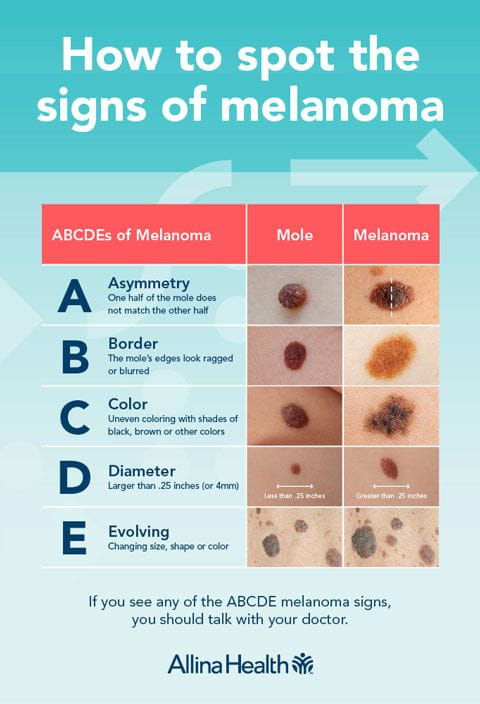
- A is for Asymmetry: One half of the spot or mole does not match the other half. Normal moles are typically symmetrical. If you were to draw a line through the middle, the two halves would look very similar.
- B is for Border: The edges are irregular, scalloped, blurred, or poorly defined. Melanomas often have uneven borders, whereas benign moles usually have smooth, even borders.
- C is for Color: The color is not uniform. Look for varying shades of brown, tan, or black. The presence of other colors like white, red, or blue is a significant warning sign. A normal mole is usually a single shade of brown.
- D is for Diameter: The mole or spot is larger than 6 millimeters in diameter (about the size of a pencil eraser). While melanomas can be smaller when first detected, any mole that is growing in size should be evaluated.
- E is for Evolving: The mole or spot is changing in size, shape, color, or elevation. Any change, or a new symptom such as bleeding, itching, or crusting, is a red flag. This also includes a spot that looks different from all of the others on your body (the “Ugly Duckling” sign).
If you notice any of these signs, it is imperative to see a dermatologist for a professional evaluation. The Cleveland Clinic emphasizes that an early diagnosis and treatment improve outcomes.
Beyond Melanoma: General Warning Signs for All Skin Cancers
While the ABCDEs are specific to melanoma, there are broader warning signs that can indicate any type of skin cancer, including BCC and SCC. It’s important to be vigilant for any new or changing features on your skin. The American Cancer Society provides a comprehensive list of general symptoms:
- A new growth, spot, or bump on the skin that is expanding or changing.
- A sore that bleeds and/or fails to heal after several weeks.
- A rough or scaly red patch, which might crust or bleed.
- A wart-like growth.
- Any spot that develops new symptoms like persistent itching, tenderness, or pain.
- A shiny, pearly, or translucent bump.
- A scar-like area without a prior injury.
The key takeaway is change. Any new or changing lesion on your skin warrants a visit to a doctor.
Special Focus: Signs in Unexpected Places & Diverse Skin Tones
Skin cancer can appear anywhere on the body, not just in sun-exposed areas. It’s crucial to check these less obvious locations during a self-exam.
- Under the Nails: A dark streak or line under a fingernail or toenail can be a sign of acral lentiginous melanoma, a type of melanoma that is more common in people of color. It can often be mistaken for a bruise.
- Palms and Soles: New or changing spots on the palms of the hands or the soles of the feet should be examined. This is another common location for acral lentiginous melanoma.
- Mucous Membranes: Check the lining of your mouth, nose, and genital areas for any new or unusual spots.
It’s a dangerous myth that people with dark skin cannot get skin cancer. While melanin offers some protection, research shows skin cancer in darker skin tones is often diagnosed late, leading to worse outcomes. As survivor Trena Brown shared, many believed melanin was complete protection—until her melanoma diagnosis proved otherwise. Her story is a reminder that everyone should know the warning signs and watch for early skin cancer symptoms.
Your Proactive Plan: A Step-by-Step Guide to Skin Self-Exams
Checking your skin regularly is one of the best ways to catch problems early. A simple five-minute self-exam each month can save your life. Since no one knows your skin better than you, you’re the first to notice subtle changes that may signal early skin cancer symptoms.
Why, When, and How to Check Your Skin
Why: Research shows that about 70% of melanomas begin as brand-new spots, not from existing moles. This makes it vital to know your skin’s normal look so you can quickly recognize any new growths or early skin cancer symptoms.
When: Most dermatologists and organizations like the American Cancer Society recommend performing a self-exam once a month. The best time is after a bath or shower, in a well-lit room.
What You’ll Need: The process is simple and requires only a few tools:
- A well-lit room.
- A full-length mirror.
- A hand mirror for hard-to-see areas.
- A comb or hairdryer to check your scalp.
- A place to record your findings, such as a notebook or a body mole map from the AAD.
The Head-to-Toe Examination Method
A systematic approach ensures you don’t miss any areas. Follow these steps as recommended by dermatologists:
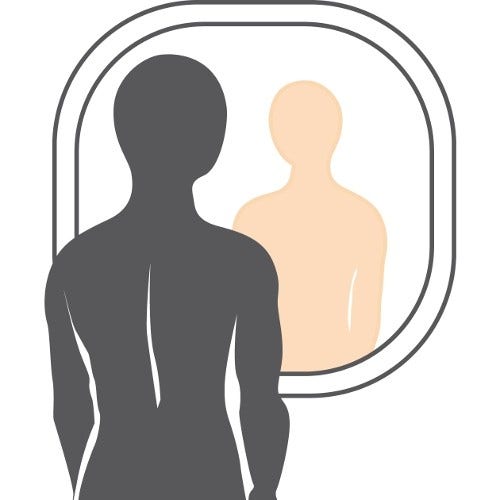
- Face & Head: Check your face carefully—nose, lips, mouth, and both sides of the ears. Use a hand mirror for close-ups and a comb or hairdryer to part your hair so you can inspect your scalp. Spotting unusual changes here can help you catch early skin cancer symptoms.
- Torso & Arms: In the full-length mirror, check your neck, chest, and torso. Women should lift their breasts to check the skin underneath. Then, examine your underarm areas, both sides of your arms, the tops and palms of your hands, in between your fingers, and under your fingernails.
- Legs & Feet: Sit down to get a clear view of your legs. Check the front of your thighs, shins, the tops of your feet, in between your toes, and under your toenails.
- Hard-to-See Areas: Use a hand mirror to check the bottoms of your feet, calves, and backs of your thighs, one leg at a time. Then examine your buttocks, genital area, lower and upper back, and the back of your neck. A full-length mirror can also help. Spotting changes in these hidden areas is vital for catching early skin cancer symptoms.
The first time you do this, take your time to learn the pattern of your moles, freckles, and other marks. Taking photos can help you track any changes over time.
Found Something Suspicious? Here’s What to Do Next.
If you notice a spot that fits the ABCDE rule or shows other warning signs, don’t ignore it. Take a clear photo for reference and book an appointment with a board-certified dermatologist right away. Early evaluation is crucial—waiting until your next annual check-up could delay treatment. Recognizing and acting on suspicious skin cancer symptoms promptly can make all the difference.
The Science of Skin Cancer: Diagnosis and Modern Treatments
When a suspicious spot is found, doctors follow specific steps to confirm a diagnosis and choose the right treatment. Thanks to advances in testing and therapies, outcomes for patients with skin cancer symptoms have improved greatly.
How Doctors Confirm a Diagnosis
The diagnostic journey typically begins with a professional examination and culminates in a lab analysis of the tissue itself.
- Professional Skin Exam: A dermatologist carefully checks your skin and may use a dermatoscope, a magnifying tool that reveals mole and lesion details invisible to the naked eye. This helps distinguish harmless spots from those showing early skin cancer symptoms.
- The Skin Biopsy: If a spot is deemed suspicious, a skin biopsy is the only way to confirm a diagnosis of cancer. This is a simple, routine procedure performed in the doctor’s office under local anesthesia. The Mayo Clinic describes the main types:
- Shave Biopsy: The doctor uses a tool similar to a razor to remove a small section from the top layers of the skin.
- Punch Biopsy: A special circular tool is used to remove a small, round core of skin, including deeper layers. This is often used if the doctor suspects the lesion penetrates more deeply.
- Staging Tests: When skin cancer is confirmed—especially melanoma or advanced SCC—doctors may run staging tests to see how far it has spread. These may include a sentinel lymph node biopsy, CT scans, or other imaging tests. According to the University of Mississippi Medical Center, staging helps guide the best treatment plan and is crucial once skin cancer symptoms are confirmed.
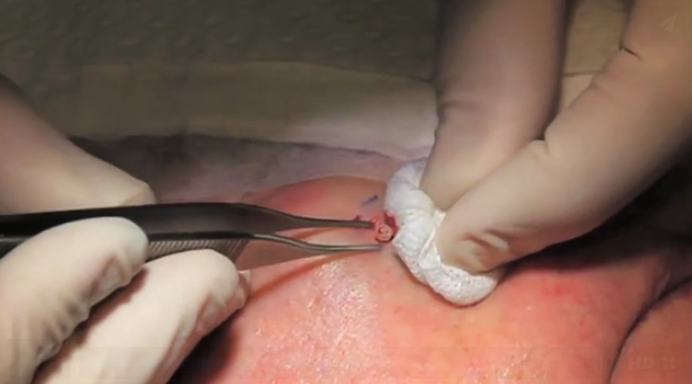
An Overview of Modern Treatment Options
Treatment for skin cancer is highly effective, especially when started early. The choice of treatment depends on the type of cancer, its size, location, and stage.
- Surgery: The most common treatment for skin cancer is surgical removal of the tumor along with a margin of healthy skin. For BCC and SCC on the face, doctors often use Mohs surgery, which removes cancer layer by layer while checking under a microscope. This ensures all cancer cells are gone while preserving healthy tissue. The American College of Mohs Surgery notes it offers the highest cure rate, especially when surgery follows early detection of skin cancer symptoms.
- Immunotherapy: This revolutionary approach has transformed the treatment of advanced melanoma. Immunotherapy drugs, known as checkpoint inhibitors (e.g., ipilimumab, nivolumab, pembrolizumab), work by unleashing the body’s own immune system to recognize and attack cancer cells. The National Cancer Institute reports that combinations of these drugs have led to long-term survival in a significant portion of patients with metastatic melanoma.
- Targeted Therapy: These drugs are designed to attack cancer cells with specific genetic mutations. For example, about half of all melanomas have a mutation in the BRAF gene. Drugs called BRAF inhibitors can target this mutation and shrink tumors. These are often used for patients whose melanoma has spread. MD Anderson provides details on these innovative treatments.
- Other Treatments: For certain cases, other therapies may be used. Radiation therapy uses high-energy rays to destroy cancer cells and may be used after surgery or if surgery is not an option. Chemotherapy, which uses drugs to kill cancer cells, is used less often for skin cancer today but may be an option for advanced cases.

The chart above, based on data cited by the American Academy of Dermatology, illustrates the dramatic increase in the incidence of the two most common non-melanoma skin cancers over a period of several decades, underscoring the growing public health challenge.
Prevention is Power: Your Ultimate Guide to Sun Safety
While early detection saves lives, the ultimate goal is to stop skin cancer from developing. Since most cases are linked to UV overexposure, prevention is in your hands. A smart sun safety routine—your first defense against skin cancer symptoms—can protect your skin for life.
Sunscreen 101: Your Daily Defense
Sunscreen is a cornerstone of skin cancer prevention, but it must be used correctly to be effective. Think of it as a non-negotiable part of your daily routine, just like brushing your teeth.

- Choose Wisely: Always select a sunscreen that offers broad-spectrum protection, meaning it protects against both UVA (aging) and UVB (burning) rays. The AAD recommends an SPF of 30 or higher.
- Apply Correctly and Generously: Most people use only half the needed sunscreen. For full protection, apply about one ounce (a shot glass full) to dry skin 15–20 minutes before going outside. Don’t miss common spots like lips, ears, the back of your neck, and the tops of your feet. Using sunscreen properly is one of the easiest ways to prevent skin cancer symptoms.
- Reapply Religiously: Sunscreen is not a one-and-done application. It must be reapplied at least every two hours, and more frequently if you are swimming, sweating, or towel drying. Set a timer on your phone as a reminder.
Beyond the Bottle: A Multi-Layered Approach
Sunscreen is just one part of a complete sun protection strategy. For the best defense, you should layer multiple forms of protection.
- Seek Shade: The sun’s UV rays are strongest between 10 a.m. and 4 p.m. Whenever possible, seek shade during these peak hours. This is a simple but highly effective way to reduce your exposure.
- Cover Up with Clothing: Clothing is one of the most effective forms of sun protection. Wear long-sleeved shirts, pants, and skirts. Look for clothing with an Ultraviolet Protection Factor (UPF) rating. A UPF of 50 blocks 98% of the sun’s rays. The Skin Cancer Foundation strongly advocates for sun-protective clothing.
- Wear a Hat: A hat is crucial for protecting your scalp, face, neck, and ears. A wide-brimmed hat (at least 3 inches all around) is far more effective than a baseball cap, which leaves the neck and ears exposed.
- Use Sunglasses: Protect your eyes and the delicate skin around them from UV damage, which can lead to cataracts as well as skin cancer on the eyelids. Choose sunglasses that block 99% or more of UVA/UVB rays.
Busting Dangerous Myths
Misinformation about sun exposure can be deadly. It’s vital to understand the facts.
- Myth: Tanning beds are a safe way to tan. Fact: This is unequivocally false. The CDC states that indoor tanning beds are a source of intense UV radiation and their use significantly increases the risk of all types of skin cancer, including melanoma. There is no such thing as a safe tan from a tanning bed.
- Myth: A “base tan” protects you from sunburn. Fact: A tan is a sign of skin damage. It is your skin’s response to injury from UV radiation. A base tan provides a negligible amount of sun protection (equivalent to an SPF of about 3) and does not protect you from the DNA damage that leads to skin cancer.
Frequently Asked Questions (FAQ): Myths vs. Facts
Q1: Can people with dark skin get skin cancer?
A1: Absolutely. This is a critical and often misunderstood point. While people with lighter skin are at a higher risk, anyone can get skin cancer. As mentioned earlier, skin cancer in individuals with darker skin is often diagnosed at a more advanced, dangerous stage because of a lack of awareness and because it can appear in less sun-exposed areas. Everyone, regardless of skin tone, should practice sun safety and perform regular skin checks.
Q2: Do I really need sunscreen on a cloudy or cold day?
A2: Yes. Up to 80% of the sun’s harmful UV rays can penetrate clouds, haze, and fog. UV radiation is present year-round, and it can also reflect off surfaces like snow, sand, and water, increasing your exposure. The CDC advises that protection from UV rays is important all year, not just during the summer.
Q3: Will using sunscreen every day cause a vitamin D deficiency?
A3: For most people, this is highly unlikely. No sunscreen blocks 100% of UV rays, and most people do not apply it perfectly or consistently enough to cause a deficiency. Most individuals get sufficient vitamin D from incidental sun exposure on small areas of unprotected skin and through a healthy diet (including fortified foods like milk and cereal, and fatty fish). If you have a diagnosed deficiency or are concerned, speak with your doctor about safe dietary supplements. Safe food sources or supplements are the recommended way to get vitamin D.
Q4: Is all skin cancer deadly?
A4: No. When caught and treated early, the cure rate for Basal Cell Carcinoma (BCC) and Squamous Cell Carcinoma (SCC) is very high. Melanoma is the most serious type due to its tendency to spread, but it is also highly treatable when detected in its earliest stages. This is precisely why understanding skin cancer symptoms and performing regular self-exams is so critical—it allows for early intervention when treatment is most effective.
Conclusion: Your Health is in Your Hands
The landscape of skin cancer is one of contrasts. It is the most common cancer, yet it is also highly preventable. It can be deadly, yet it is highly curable when found early. The power to shift the odds in your favor lies directly with you, through awareness and action.
Key Takeaways
From the story of Michael Clarke to the detailed science, the path to protecting yourself is clear. Remember these three essential actions:
- Know Your Skin: Your skin’s landscape is unique. By performing regular monthly self-exams, you become the foremost expert on what is normal for you, making it easier to spot any changes.
- Learn the Signs: Commit the ABCDEs of melanoma to memory and be aware of the general warning signs for all skin cancers. Recognizing these crucial skin cancer symptoms is your first line of defense.
- Protect Yourself Daily: Make sun safety a non-negotiable, year-round habit. This includes using sunscreen, wearing protective clothing, seeking shade, and avoiding indoor tanning.
Stories of patients like Trena Brown and Leah Adams show the human side of skin cancer and the strength of advocacy. While a diagnosis can feel overwhelming, awareness and proactive steps make a real difference. Recognizing skin cancer symptoms early saves lives, and prevention builds a healthier future.
For personal stories and tips on managing life and mental health after a skin cancer diagnosis, check out our post [Life After Cancer: How to Manage Side Effects and Rebuild Mental Health].
Medical Disclaimer
This article is for educational purposes only and is not a substitute for professional medical advice, diagnosis, or treatment. Always consult a qualified healthcare provider before making medical decisions.
